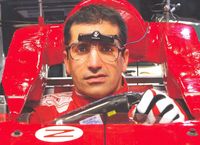Ferrari Launches the Ultimate Driving Simulator
MARANELLO, ITALY – December 28, 2009: Ferrari has launched the ultimate driving simulator to help hone its Formula One cars and drivers, but weighing in at more than 200 tonnes, with ten computers, 60 GB of RAM, five giant 3D video screens and a 3500 watt Dolby sound system, this isn’t a driving game that’s going to be in anyone’s Christmas stocking!
The Ferrari Formula One Driving simulator will enable the most successful team in Formula One to develop their Formula One cars and train its drivers to use new technology and to race on new tracks without breaking the rules limiting testing in the real world.
“No driving simulator is capable of reproducing the real feeling that a driver experiences in a Formula One car: the sensitivity expert drivers such as those in Formula 1 is too high to create the impression of being in a real car,” explains Marco Fainello, Head of Vehicle Performance the designer of the simulator. “Nevertheless, simulators can provide some sensations (visual, forces, movement, vibration, noise) which in some areas are identical, in others are similar or in others still, are different but close enough to real ones.
“This means it is possible to drive a model of a virtual vehicle, experiencing sensations that can be referenced to a real one. With a sufficiently experienced driver and engineers, who analyse the results, it is possible for a simulator test to produce data useful to the development of the car and in terms of how the driver interacts with the handling and the controls on the vehicle,” explains Mr Fainello.
The first virtual laps at the wheel of the simulator were driven by Andrea Bertolini, who worked with the Ferrari engineers on the development of the project, having gained a great deal of experience over the past few years, working on the simulator at the FIAT Research Centre which used to develop Fiat Group road cars.
The Ferrari simulator, built with the technical support of Moog, consists of an aluminium and composite structure in which are fitted the Formula One Car cockpit and the equipment which produces the images and sound. The platform weighs around two tonnes and is fitted with electronically controlled hydraulic actuators that way around half a tonne each. The whole structure is fitted on a specially designed and built base, weighing two hundred tons.
The whole system is controlled by ten linked computers with a total memory of more than 60 GB of RAM. It features a Dolby Surround 7.1 sound system, putting out 3500 W. The installation required more than ten kilometres of cabling and a power supply of 130 kW. The simulator is housed in a building measuring around 180 square metres, on two floors, which includes the control room.
The platform covers a surface area of around eight metres wide by the same length and is six metres high. The driver is installed in front of five very large video displays, which give a total viewing angle in excess of 180°.
"The completion of this project means we will now be able to tackle with confidence some of the challenges that make up modern-day Formula 1, while putting Ferrari at the cutting edge in terms of this technology," said Stefano Domenicali, Ferrari Formula One Team Principal. "Furthermore, I am pleased that such a complex project as this, which got underway around two years ago, has been completed on schedule thanks to the efforts of all those who worked on it."



